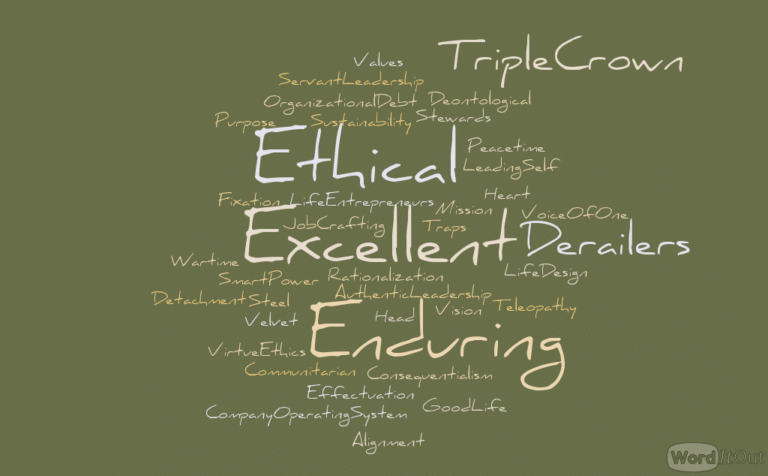Our triple crown leadership model has three dimensions: excellent, ethical, and enduring. Some people wonder whether triple crown leadership requires giving equal priority to “excellent,” “ethical,” and “enduring” considerations.
Many ask, “Don’t we have to sometimes tilt toward the short-term results just to survive, thereby, sacrificing the long-term?”
Others may wonder, “In my business everyone is cutting ethical corners. How do we survive?”
Tilts
Of course, sometimes temporary “tilts” are required between the “three Es.”
Sometimes short-term considerations must take precedence in order to save the organization. Heavy criticism may follow, but it will be moot if the organization goes out of business. At other times, the reverse is needed: leaders must be willing to dampen expectations for short-term results to make the critical, long-term investments needed.
In each case, it is essential to be transparent, explaining to all stakeholders the rationale behind your actions, and why your temporary tilt is essential. If you have built credibility and trust with your constituents, many of them will understand, appreciate your candor, and likely ride along. The short-term day traders may abandon you. Let them go.
But triple crown leaders never compromise on the ethical imperative.
If they did, they would be failing their organization, setting a bad precedent and undermining their credibility.
Harvard’s Clayton Christensen says,
“It’s easier to be ethical 100% of the time.”
Why? Because once you comprise your integrity, it is so much easier to rationalize further unethical behavior.
Better to fail with honor than succeed with disgrace. And there are real benefits to ethical behavior, though they make take a while to bear fruit.
Infosys competes in India where corruption is rampant. Infosys set out to be India’s most respected company, delivering on promises, treating employees fairly, operating with transparency and accountability, and upholding all laws. Since then, Infosys has been among the world’s fastest growing large companies and most respected companies.
When Infosys imported its first computer in 1984, they ignored a requested bribe, paying a duty ten times higher than normal. It took six years to recover the funds through a protest process. Similarly, Infosys paid a 40 percent premium for its Bangalore headquarters land after refusing to pay a bribe. The company’s rivals manipulated their imported software invoices to pay lower duties. While lawyers advised that such actions were not illegal, Infosys leaders refused to operate with such deception.
Infosys co-founder N.R. Narayana Murthy said,
“It took just a few years for corrupt officials to stop approaching us for favors. Because of Infosys’ ethical image, our clients entrusted us with increasingly bigger projects. Our values have thus become our advantage…”
Leaders must decide when short- and long-term tilts are necessary, but the ethical imperative is sacrosanct.
Practical Applications:
1. Do you explain your short- or long-term tilts to your stakeholders?
2. Have you decided always to uphold the ethical imperative?
++++++++++++++++++++++
Bob Vanourek and Gregg Vanourek are leadership practitioners, teachers, trainers, and award-winning authors. They are co-authors of Triple Crown Leadership: Building Excellent, Ethical, and Enduring Organizations, a winner of the International Book Awards, and called “the best book on leadership since Good to Great.” Take their Leadership Derailers Assessment or sign up for their newsletter. If you found value in this, please forward it to a friend. Every little bit helps!


